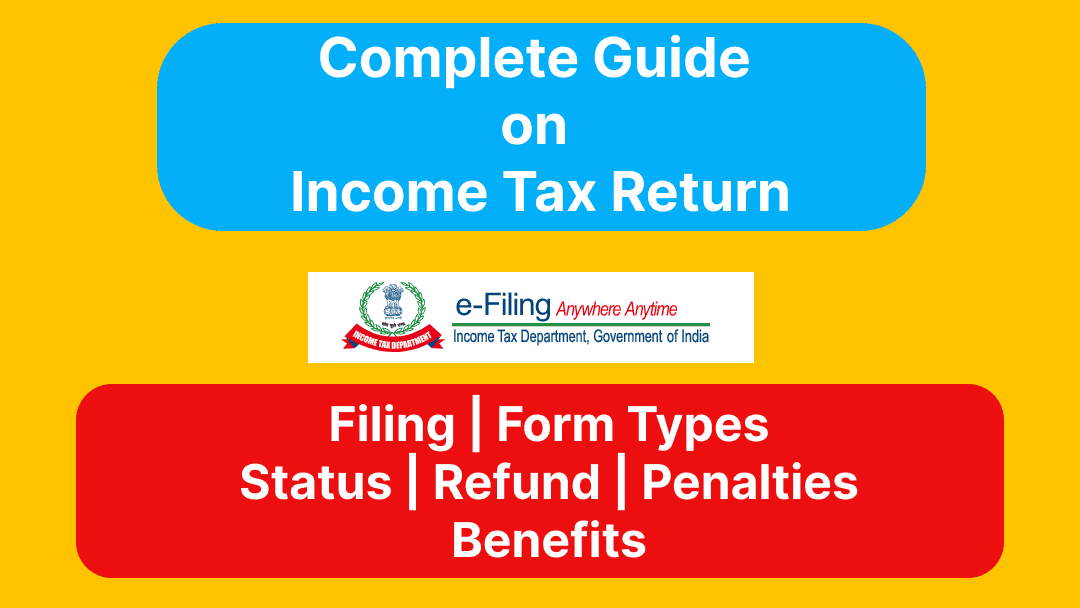

Income Tax Return
Income Tax Return also popularly known as ITR is a form that a person / taxpayer in Indian has to submit to the Income Tax Department of India. It contains all information about the person’s income and the taxes to be paid on it during the financial year.
As PAN & Aadhar are linked so it’s very easy to track income(as bank accounts also linked with Aadhaar & PAN) of a person in India. It’s mandatory to Link PAN Card with Aadhaar, otherwise there is a provision of penalty.
There are different types of ITR forms depending on the taxpayer’s sources of income, the amount of income and the category of the taxpayer, such as Individuals, HUFs, Companies, etc. You can find the details of the various ITR forms here on Income Tax Department website portal: https://incometaxindia.gov.in/
Know why it’s important to file ITR for tax payers in India:
The Income Tax Return filing due date | Last Date for filing ITR for FY 2022-23 (AY 2021-22) is 31st July 2023 for most taxpayers.
However, there are some exceptions and extensions for certain cases. You can check the latest updates here: https://www.incometaxindia.gov.in/Pages/important-due-dates.aspx
Important Tax Due dates or Return Filing dates can be seen can be seen in tax calendar below:
https://incometaxindia.gov.in/Pages/yearly-deadlines-details.aspx?yfmv=2023
Filing ITR is important as it helps you to claim refunds, carry forward losses, apply for loans or visas, and comply with the law. If you fail to file ITR on time, you may have to pay penalties and interest on tax dues. You may also face scrutiny or prosecution from the tax authorities.
In India there are different types of forms available which we have to file as per type of income tax payer and as per source of income.
This form is for individuals who are resident in India and have a total income of up to Rs 50 lakh from salary, one house property and other sources (such as interest income). This form cannot be used by NRIs, directors of companies, holders of unlisted equity shares or those who have foreign income or assets.
This form is for individuals and HUFs who do not have income from business or profession. This form can be used by those who have income from salary, more than one house property, capital gains, foreign income or assets, agricultural income exceeding Rs 5000, lottery or horse race winnings, etc.
This form is for individuals and HUFs who have income from business or profession. This form can also be used by those who have income from salary, house property, capital gains, other sources, foreign income or assets, etc. This form is also applicable for those who are partners in a firm but do not carry out any business or profession under the firm.
This form is for individuals, HUFs and partnership firms (other than LLPs) who have income under the presumptive taxation scheme. This scheme is applicable for those who have income from business with turnover up to Rs 2 crore (under section 44AD) or income from profession with gross receipts up to Rs 50 lakh (under section 44ADA). This form cannot be used by those who have income from more than one house property, capital gains, speculative income, agency business, commission or brokerage income, foreign income or assets, etc.
This form is for persons other than individuals, HUFs, companies and persons filing ITR-7. This includes LLPs, AOPs, BOIs, artificial juridical persons, cooperative societies, local authorities, etc. This form can be used to report income from any source¹.
This form is for companies other than those claiming exemption under section 11 (charitable or religious trusts). This form can be used to report income from any source. However, this form can only be filed electronically with a digital signature¹.
This form is for persons including companies who are required to file returns under sections 139(4A), 139(4B), 139(4C), 139(4D), 139(4E) or 139(4F). These include trusts, political parties, institutions, colleges, investment funds, etc.
You can find more details about each ITR form and their eligibility criteria on the official website of the Income Tax Department: https://www.incometaxindia.gov.in/Pages/downloads/income-tax-return.aspx
According to the Income Tax Act of India, you may have to pay a penalty for late filing of Income Tax Return. The penalty amount depends on the taxpayer’s total income and the date of filing. Here we have explained details:
– If you file your ITR after the due date of 31st July 2022 but before 31st December 2022, you have to pay a penalty of Rs. 5,000. However, if your total income does not exceed Rs. 5 Lakhs, the penalty is Rs. 1,000.
– If you file your ITR after 31st December 2022 but before 31st March 2023, you have to pay a penalty of Rs. 5,000 regardless of what your total income is.
– If your income is taxable and you do not file your ITR at all, you may face prosecution under Section 276CC of the Income Tax Act and imprisonment of 3 Months to 7 Years with fine, depending on the amount of tax you have evaded.
Apart from above mentioned penalty, you may also have to pay interest on the unpaid tax at the rate of 1% per month under Section 234A of the Income Tax Act. Moreover, you may lose the benefit of carrying forward your losses and claiming refunds if any.
Therefore, it is advisable to file your Income Tax Return on time and avoid any inconvenience or extra financial cost.
Benefits of filing ITR online are listed below:
to file online income tax return, one needs below documents handy
You can check the status of your ITR online by following these steps:
– Go to the Income Tax e-Filing portal: https://www.incometax.gov.in/iec/foportal/
– Click on Income Tax Return (ITR) Status under the Quick Links option on the homepage.
– Enter your ITR acknowledgement number and a valid mobile number and click Continue.
– Enter the 6-digit OTP received on your mobile number and click Submit. You will be able to view the ITR status.
Alternatively, you can also check the status of your ITR by following below steps:
You will be able to download the ITR-V Acknowledgement, complete ITR form in PDF, and intimation order from there.
Getting Income Tax Refund depends on what kind of refund you are looking for.
income tax refund, you can claim by filing your income tax return online and declaring your income, deduction and tax paid details to the Income Tax Department1.
You can check the status of your income tax refund online on the NSDL website or the e-filing portal by entering your PAN and Assessment Year.
If you have paid taxes more than your liability for the FY then you are eligible for an income tax refund.
In India Income Tax Refund takes 20-45 days from the date of e-verification of ITR to get your refund credited in your bank account.
However, the time may vary depending on the mode of refund, bank processes and when your ITR is processed by the Income Tax Department.
You can track your refund status online on the NSDL website: https://nsdl.co.in/ or the e-filing portal by entering your PAN and Assessment Year.
To check your income tax refund status on the NSDL website, you can follow below steps:
| Join Haryana Blogs Telegram Channel | Join Telegram |
| Join Haryana Blogs WhatsApp Group | Join WhatsApp |
| Follow Twitter | Follow |
| Follow / Like Facebook Page | Follow |
Other Govt. Jobs for you: